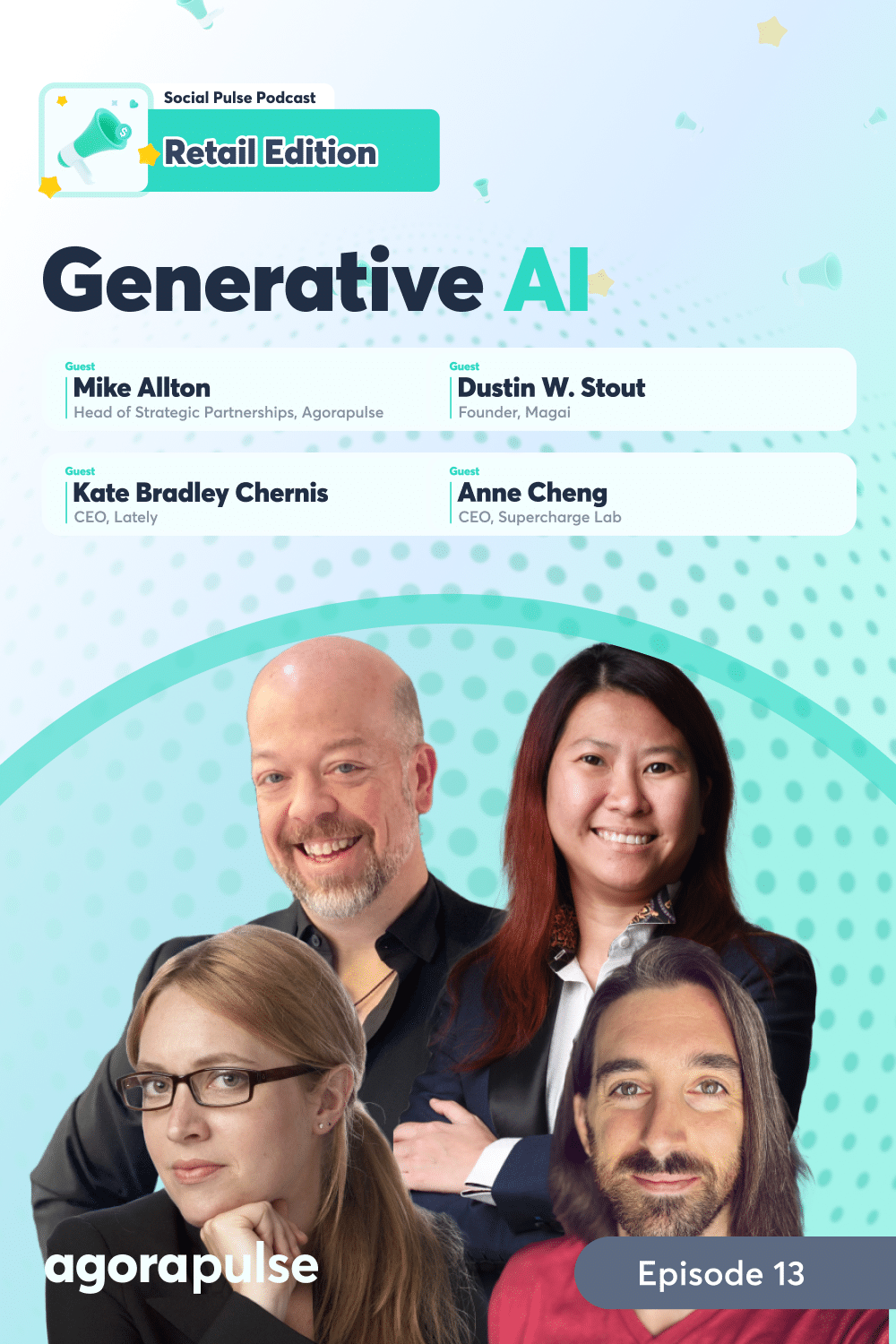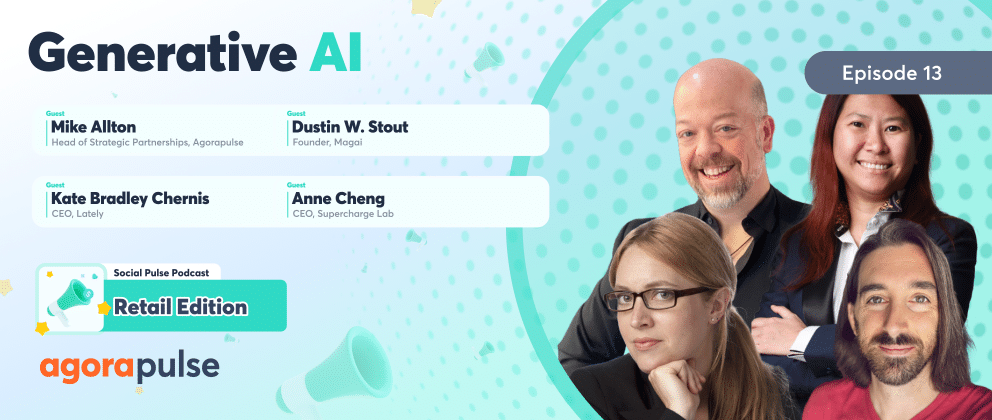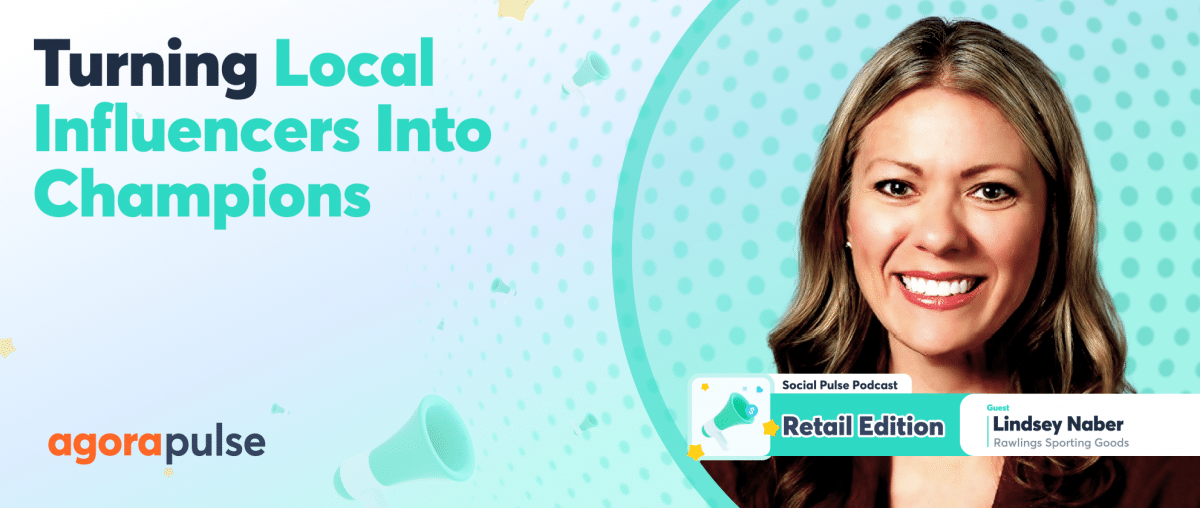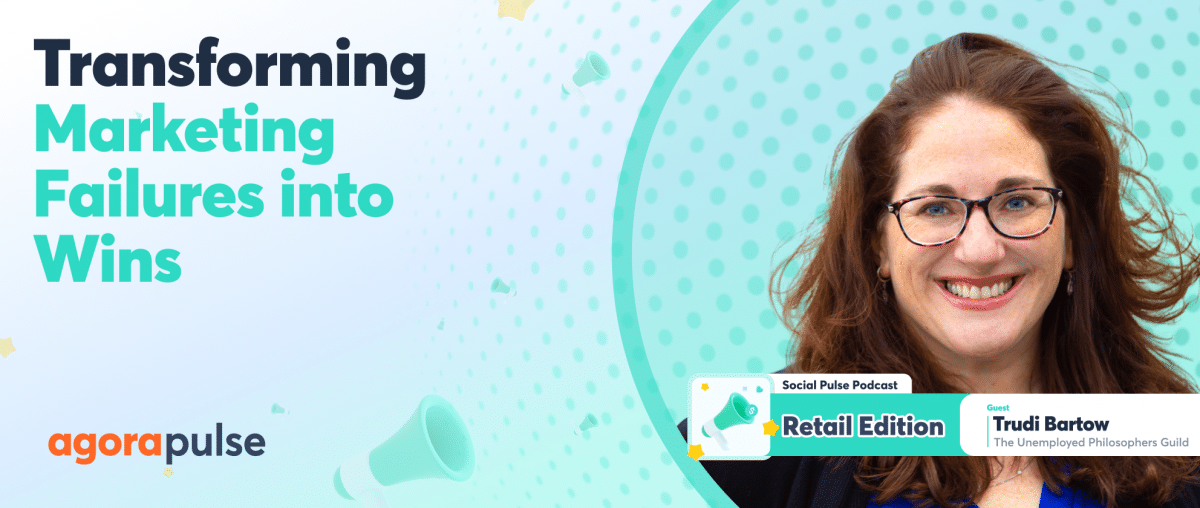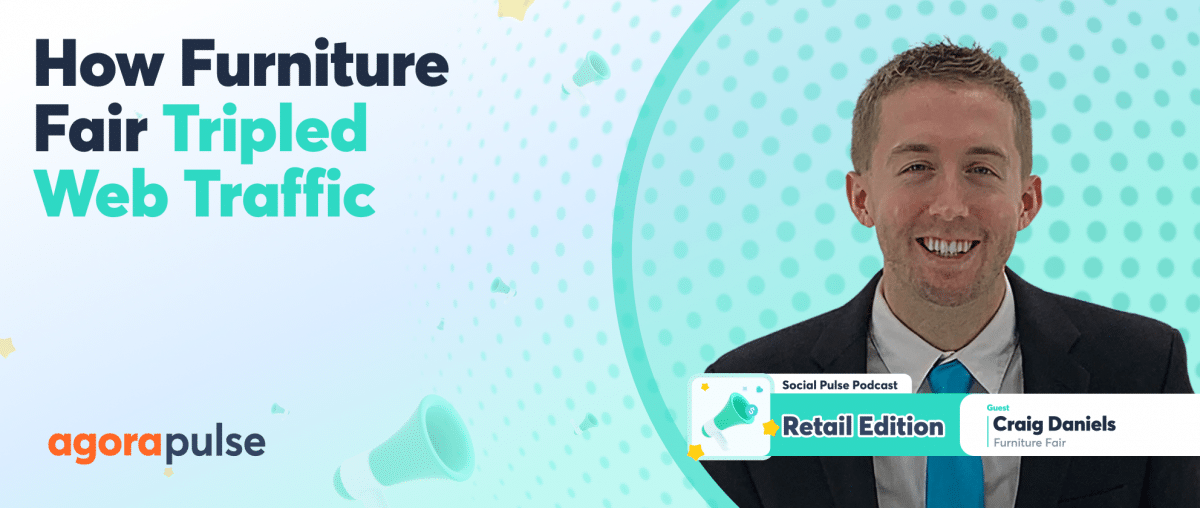Curious about generative AI and its impact in retail marketing? In the latest episode of Social Pulse Podcast: Retail Edition, AI experts and SaaS founders: Dustin W. Stout, founder of Magai, Kate Bradley Chernis, CEO of Lately, and Anne Cheng, CEO of Supercharge Lab discuss those topics with host Mike Allton, chief storyteller at Agorapulse.
Listen to the entire podcast here or read on for the transcript.
Solutions These Panelists Bring to the AI Marketing Table
Mike Allton: I want each of you to share about your solution. You know, [Kate], so share more about Lately and specifically how it intersects AI, retail marketing, and social media. We’re talking to social media managers and community managers here for the most part attending the summit today. Tell us more about Lately from that perspective.
Kate Bradley Chernis: When you connect your social channels to Lately, what we do is we instantly study all of the analytics from those channels (Facebook, Twitter, Instagram, etc). And we’re looking for patterns and two specific kinds of patterns.
The first is: When you write content well on social media, what makes it do so well? What’s the DNA of it? What are the words, the ideas, the phrases, the sentence structures, and even the composition? Is it a link in some text? Is it video and text, etc?
Then the second pattern we’re looking at is: When your unique target audience engages with your content, what makes them click, like, comment, and share?
So once I have that pattern, the AI starts to learn on its own all the time, and it’s referencing best practices and all the data that we’ve amassed over the last 10 years. And then we are able to generate content based on what we’ve learned about you, so that it’s in your voice and then targeting that exact audience.
So we do this all through a social media management platform that can integrate with others and/or you can do it through us, like all that kind of stuff.
Mike Allton: Anne, what can you share more with us?
Anne Cheng: Yeah, for sure. So, we just launched Sigmund AI 2.0, which is an updated version of it. I love how Kate said, we’re all obsessed with saving time but not making money.
The truth is a lot of us are just trying to beat the algorithms of the powers that be. What Sigmund now does is that it gives the powers that be that feedback loop and basically puts you ahead of your competitors—only because your competitors are trying to beat Google and Facebook and all that jazz.
But really, nobody’s just telling Google and Facebook what’s working and what’s not. So, if you keep telling Google and Facebook what’s working and what’s not, you get ahead.
That’s how the algorithm works right now. It’s called value-based bidding. So Sigmund AI is still the same thing. It still does end-to-end operating of your digital marketing agency for small agency owners or scale-up agency owners. It just does it easier, better, faster, with a lot more analytics.
Mike Allton: I love that you referenced the futility of trying to beat the algorithm. I mean, it’s just too many people [in] the audience thinking, “Yeah, I’m tired of pushing that hill, that rock up that hill.” Dustin, share more with us about Magai.
Dustin Stout: Magai is the all-in-one AI platform to help real people get work done.
So, the great thing about the time that we live in right now is it’s so exciting, right? ChatGPT came out and completely changed the world. And then Claude came out and started the arms race of AI, so to speak. And now we’ve got Google Bard, which has now become Gemini, and Gemini is evolving into something else. And then we’ve got these other companies all racing to become the best AI company that there is.
And so what Magai has effectively solved for a lot of professionals is: It’s not sustainable to play this game of, “Oh, let’s go use ChatGPT, because they just came out with this feature. Oh, wait, Claude just came out with some other feature. Let’s go try that one over here. Oh no. Now Google Gemini is even better.” So, you end up having this game of running from one app, one tool to another, having to relearn all the things, and having 15 different subscriptions. You need an image generator over here, this other image generator, this video generator.
Magai solves all of that headache by putting all of the world’s best AI tools—ChatGPT, Claude, Bard, Gemini, Leonardo AI, Stable Diffusion, text to video, all of it—in one beautiful interface under one subscription for your entire team. So [Magai is] effectively saving you from having to spend $1,000 on all these different tools and instead having one unified subscription and a unified interface with things like folders, different workspaces for different clients, or different projects to keep things organized, searchable, findable—all so that you don’t have to play this back-and-forth game of changing your standard operating procedures every time a new app comes out with a new feature. Every AI tool [is] in one beautiful interface.
What to Do (and What Not to Do) for Retail Social Media Marketing
Mike Allton: Now let’s get into some of the details about AI in this intersection with AI and social media marketing.
We’re seeing this all the time, but a lot of the folks that are watching us today, their job is to maintain their presence on social media as a brand, and they’re trying to keep up with the platforms and the algorithms that we already referenced, and they’re struggling to figure out what’s going on with AI.
What should I be doing? What should I not be doing?
What do you think the number-one challenge might be for retail social media managers today that AI can help with and how?
Dustin Stout: Retail social media managers have a really challenging job. And I think to sum it up into one particular struggle is difficult because there are many social media managers. I was one for many, many years. I worked for a plethora of different brands and businesses and clients. And I know that the struggle is real, like having to prove KPIs, having to generate content constantly, and trying to switch. If you’re working with multiple clients, you have to switch creative sides of your brain and take on one brand voice and take on another. So there’s a lot of challenges.
And I think the one thing that AI above all things is insanely good at is becoming a supplement to your own creativity.
Now, I’ll paint a picture for you: I ran a marketing agency since 2012, then I started freelancing as a social media consultant and ended up working for a number of other agencies, a subcontractor worked with everything from plumbers, lawyers, retail companies, product companies, SaaS, hosting companies, resorts, women’s rejuvenation clinics.
The hardest thing for me was I only had so much energy in a day. I only had so much creativity in a day. Now, I believe we’re all insanely creative. Like this creative energy that we have is given to us from our creator, and it is unending, but we—our bodies, our minds—they fatigue, they get tired, and we get burnt out.
And so for me, the struggle was constantly, “How do I give my best creativity to every one of my clients?” Or if you’re working for a business, “How do I give my best creativity every single day, trying to generate massive amounts of content to get as much reach as possible?”
And so I think AI helps with that. It’s the supplemental creativity that saves you from burning yourself out on trying to come up with a thousand different ideas every single week.
A lot of how I built Magai was for that purpose of a content creator needing to generate ideas. And not only do they need to generate ideas but they need to organize them. They need their team to come in and contribute. And so I think AI is a lifesaver for the people who are in the creative seats trying to generate social media content daily. And it can save you from burning out, like I had time after time.
Mike Allton: Completely agree. Kate, what would you add?
Kate Bradley Chernis: One of the challenges that we see, honestly, is [what] I’m going to call it laziness (and I’ve been there, too) but this sort of expectation or a misalignment of the expectation of what AI does.
People really just want to push that button and have it do everything for them and not do a darn thing. And we’re not there.
There’s a symbiotic relationship between humans and AI at this point, meaning that a human must analyze and course-correct what comes out because there’s no way for the AI to get it right all the time.
One of the things that we’ve been working on at Lately is that we plugged in a continuous performance learning loop, so that we’re always able to reference your analytics to the content we create, right? So there’s the connection there as opposed to pulling it out of thin air.
But there’s still this like, “Oh, I’m just going to pull it out of thin air and let it rip.” And we see customers doing that all the time. Like, we’re watching them online. I can see what they produce. And I’m like, “Why did you let the AI do that for you? I can see that’s a non sequitur.” For example, you have to go in and make a change that the AI learns. Don’t start the sentence “with,” “and,” “for example,” right? And when you’re able to take that, if you have the ownership of it, you get infinitely better results.
The thing that Anne was referencing was right before we pushed record today, I had said, “We see this constant conflict between saving time,” which is really important. Dustin just mentioned it’s a lifesaver.
It is a lifesaver as all technology has come to be right in one way or the other. It’s helping people get that jumping point together. The fear of the blank page is gone. But once you get that out, your next objective has to be, “Okay, well, saving time is great. Thanks so much, but what am I going to do with this? What’s the effect?” And we find a conflict between the social media managers, the people on the ground, and their bosses. These guys want to save time. Those guys, girls, whoever—they want to save money. They want to make money.
Mike Allton: Yeah, that’s absolutely right. And you’re spot-on about the need to review the output that is coming from AI and make corrections. You got to do that.
My friend and colleague Katie Richman preaches to treat the AI like an intern who’s going to maybe do great work for you, but they need to be trained, and they need to be monitored, and they need to be coached. Then you just can’t hire an intern, and expect them to go off and do an amazing job on their own. That wouldn’t be realistic. We’ll be able to treat AI the same way. Anne, what would you add to that point?
Anne Cheng: Sometimes, we think that AI can do a lot of things and then there’s the other side of the spectrum where everybody says, “Oh, AI is your intern and can do no sh*t.”
I think that is a nuanced view that I would take. There are a lot of advanced AI solutions that are out there, and in retail, I think the biggest problem is there are so many SKUs, there are so many products. Every day I am looking at some of my clients, and they’re getting rejection notices from their ads managers. “There’s a problem with your product. That’s a problem with your campaign.” And it’s one product out of 200,000 products that has a problem, and the whole campaign goes down. I think a lot of times, there are a lot of intelligent workflows. There are a lot of advanced AI solutions that can do the work for you. And we’re not leveraging them because we don’t know that there are these tools out there, or we think that you still need a human being to do everything. So I think that there needs to be a balanced approach, right? For the new models, that as they get to know you, they need to be trained obviously, but there are a lot of solutions. Once they have come up to speed, they’ll be your best intern ever. They’ll be your best employee ever. I think we all need to learn how to use the solutions instead of just saying, “Oh my God, it’s so stupid.”
Kate Bradley Chernis: One of the things that we found is that in our research of how to get the client to work with the models and train it and get it up to speed. I found like a real pushback against that. And so I was reading this article talking about how across the globe, there’s a skills vacuum of analytics.
Specifically, human beings have lost the ability to just analyze and identify problems because there’s been a huge push in the last few decades of, “Show me a solution. Don’t bring me a problem.” Right? So even high school students, for example, know they can use Google to find information and answers, but they don’t know what query to type in.
Anne Cheng: I think that’s a lack of intellectual curiosity at an epidemic level. You know, it’s crazy. People don’t think anymore, right?
Kate Bradley Chernis: We just grunt out emojis.
Mike Allton: That’s so true. And I loved, Anne, that you mentioned the fact that there are so many new tools out that we don’t even know about. I mean, it feels like every single day, there’s a new function or a capability out there that’s simply stunning, but there’s so much to help us filter through the noise.
What Should We Start Doing Today?
What can folks do today, whether it’s with your solution or in general that we might not have seen but should absolutely be aware of in utilizing?
Anne Cheng: Can I just reference Kate and say that we just need to start thinking?
The biggest problem that we’re having is that people are not thinking. So if you ask me what’s the biggest tool you have, it’s between your two ears. Just start there, and things will flow.
Google. It’s your best friend, right? Just start with your brain, and use Google. I’m sorry to say that, but, other than that, there are a lot of intelligent workflow solutions out there, including Sigmund, Zapier, and the amazing solutions that are referenced here, like Lately and Magai. These are amazing solutions.
You just need to have a little bit of patience, a little bit of heart, and a little bit of mind to actually try using it and be present.
Kate Bradley Chernis: That’s something that is so interesting to us. We’ve had this experience, a few times now, of a CIO coming to us with this totally open mindset, and we’re able to land those sales the quickest—as opposed to when we’re talking to A CMO or even a CRO. But it’s amazing to me. Marketing seems to be behind overall. Having a hard time changing in general, as we all know, like it’s always Silo City, but here we are again, and they’re caught in the loop, and the other people around them are pushing. I see you nodding your head, Dustin, so you’ve probably had this experience too, but, you know, come on, Marketing, get it together, right?
Anne Cheng: I think there’s a threat, right? They perceive it as a threat, and there’s a lot of fear, which is bubbling to the surface. So, I remember the first time I went into an agency, and I presented my solution, and they were horrified, and they said, “Holy sh*t, you don’t need us anymore.” And I went, “Well, are you sure?”
Kate Bradley Chernis: They’re not valued themselves because they’re not valuing what you said. Like what’s between your ears.
Here, I want to share this story real quick with you guys so that hopefully the audience will understand. It’s one of my favorite metaphors:
Betty Crocker in the States
- They make all kinds of bakery-related things and they launched cake in a box, right? So everybody has had that in college or wherever else. At the time, [the instructions were] only “add water.” So that’s all you had to do.
- The housewives who were the target audience thought, “This is totally weird. Like, I didn’t bake anything,” and they had no ownership in the product.
- And so Betty Crocker removed the powdered eggs, and their tagline became: Just add an egg.
- The sales skyrocketed because the humans felt some ownership in the “technology.”
That’s one of the things I like to share a lot with the people who have that fear that you pointed out, Anne, on how this symbiotic relationship is really powerful and can be a win-win-win if everybody participates and puts their skin in the game, you might say.
Mike Allton: Fascinating. Dustin, what do you think?
Dustin Stout: I think there’s a lot of challenges that marketing teams, in particular, those in retail. Like I said earlier, they have a lot of problems—the KPIs in particular—trying to prove to their bosses or managers that what they’re doing is improving the bottom line.
The reason that there’s this feeling that the industry as a whole is behind or not moving as quickly as they should into this new field. It’s like Anne said, there’s this fear of, “Oh-no, I’m obsolete,” or “I’m going to be obsolete. I can’t adopt this new technology or this new way of doing things because maybe it will replace me.” Or there’s a lot of fear, a lot of anxiety, a lot of insecurity that is, I think, holding people back from just embracing the technology full force as they could.
The thing I keep telling people—and I didn’t invent this phrase, it’s been said probably ad nauseam at this point—but …
AI is not going to replace you anytime soon. Somebody using AI is going to replace you.
And so I think the faster that anybody in a professional capacity embraces AI and starts to really play with and understand the capabilities and the potential for supplementing their creative skills or their current skills. I think everybody on here has expressed in some way that the AI isn’t quite as good as some people think it is. And the minute a social media manager has to generate some social media content, you’ll find out real quick. If you have any skill in the realm of social media, AI is not nearly as good as you. So it always takes that layer of a human expert to oversee, to edit, to, be the editor-in-chief, so to speak.
I think it’s just a matter of dropping our insecurities, dropping the fear, and realizing this is a paradigm shift in our society and our culture, everything is going to be affected, and those who adapt faster are going to have the advantage. They’re going to have the most job security. They’re going to have the most success in the future because they get on top of it early. The only way to get on top of that trend is to just start using the tools. There’s a lot of them out there. There are a lot of cool ones. I would just start exploring as much as I can to find that free time to just play.
Most of us remember when Google came on the scene. We remember a time before Google, right? We had phone books. We had directories. It took a while to realize, like, “Oh, wait, I could just Google that.” It took some behavioral changes. Behavioral change is one of the hardest things—and [one of the] longest things to change in human beings because we’re creatures of habit. We get used to certain things, but it’s going to take some time.
How did we learn how to Google things? We just started Googling things. At first it was Googling funny videos. “Charlie bit my finger,” right? And that was it. That was what we Googled. But soon we realized, “Oh, I can look up this business address,” or, “Oh, I can do math in the Google search. Oh, I can find stuff that I would normally find in a library.”
It took some time, but what did it take Googling stuff? And so in the same way, the more we use AI, the more we interact with these chatbots, the more we play with the image generators. The more we realize we can use them, the more we unlock a cognitive capacity of how to utilize these tools.
Kate Bradley Chernis: I’m sure, by the way, Anne and Dustin, you’ve seen this with your customers. But one of my favorite things is to see the way that they use Lately in ways that we haven’t imagined. And it happens all the time, right?
Dustin Stout: Yeah. Oh, man, I’ve got stories about Magai. Oh, I could talk for an hour about things. Customers blow my mind with how they use it. Learn, figure out how to use AI. Find me in a back corner, in an alley somewhere or a bar. I’ll tell you the story about the director who used it on his script.
Kate Bradley Chernis: What’s so cool is it’s informed how we’ve altered the product or how we’ve altered our product roadmap when we’ve seen that stuff. It doesn’t take very long. You can see one or two people start to do the same thing. And then you’re like, “Oh, my God. All right, let’s move it in that direction more.” But those are the people who you’re talking about, the change makers who are embracing it. They’re leading the pathway. And I wish we could figure out how to target more of them, obviously, and use AI to do that. That probably should be on my wish list of things to do.
The One Big Advice Piece You Need to Follow
Mike Allton: Well, in the just a few minutes that we have left, I want you each to give the social media managers and community managers that are watching today one piece of actionable advice in 30 seconds or less.
What was your one big tip for them?
Dustin Stout: One of the things that is really hard if you’re working for businesses in social media, and maybe you have multiple different clients, or maybe you just have different audiences that you’re speaking to for the brand. Maybe you have several different personas. I’m speaking to those social media managers right now who have multiple voices that they have to create content under that.
For me, as a writer, one of the hardest things to do was write in a voice that was not my own and be consistent at it.
One of the things that AI is exceptionally good at is you feeding it the brand voice and being as detailed as you can and having the AI generate content in that voice. And I think that’s probably something Kate has spent a lot of time on with Lately.
Something that I focus on a lot at Magai: give the user the ability to create these AI personas that could then take on your brand voice instructions for a client or the business that you work for and save it to the AI so that when you do have it produce something for you, it will produce it in such a way that it needs minimal editing.
For the most part, AI generates pretty generic stuff, and a lot of times you can tell, “Oh, that was AI-generated.” But if you’ve taken the time to craft a brand voice and instruct the AI to speak in that brand voice, if you do a really good job at it, the editing time is actually pretty minimal. So, do that.
Kate Bradley Chernis: Yeah. I mean, what you put in is what you get out. If you’re not willing to put the effort on the front side, as Dustin pointed out. And we see that all the time.
What I want people to start doing is change their mindset. Move it from “save time” to “make money.”
One of the things that I did as a precursor to Lately was I got Walmart 130 percent ROI year over year for three years doing what is now the prototype for what we built Lately. And even then I had to add all kinds of spreadsheets and PowerPoints—but to show them how what we were doing was actually making more money. And then this lightbulb went off.
When people embrace that, then you get a raise, right? It’s not about just getting the job done and going home in eight hours. If you’re able to perform better work, you know, then you’re moving up in the ladder. So I think perhaps “expect more of yourself” would be my advice.
Mike Allton: Awesome. Anne?
Anne Cheng: Do or do not. There is no try. Famous last words.
Mike Allton: Thank you, panelists. This has been fantastic.
Hope you’ve enjoyed today’s episode of the Social Pulse Podcast: Agency Edition. Don’t forget to find us on Apple and leave us a review. We’d love to know what you think. Until next time.
